Kirsten D. sent us this link to a series of Playmobil families. She notes how the families are all racially marked (using racial categories like “Asian” and “African” instead of nationality categories like “Japanese” and “Somalian”). The “Mediterranean/Hispanic” category also points to the social construction of race and the way in which social construction varies across cultures (Playmobil are made in Germany).
They families are also racially homogeneous. In the world of Playmobil (at least how it is sold, though not necessarily how it is played with) there are no interracial families and, therefore, no bi- or multi-racial people. In this way the toys reify racial categories and naturalize racial matching in relationships.
African/African American Family:
Mediterranean/Hispanic Family:
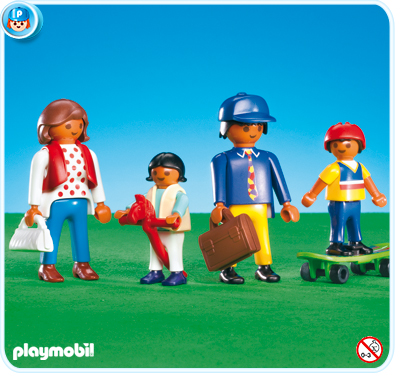
Asian Family:
Native American Family:
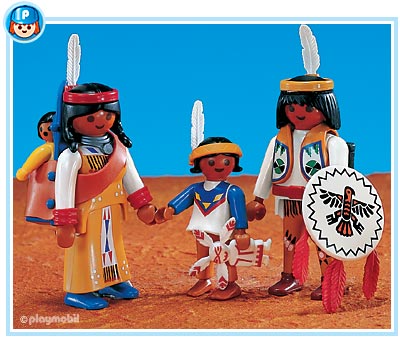
Notice also that all of the families are in contemporary clothes except for the Native American family. Ethnicized groups are often represented in “native” costume, but this is especially true for American Indians (at least in the U.S.). It is as if, in the popular imagination, American Indians are extinct; as if there are no American Indians alive today walking around in Nikes (there are).
So, in the world of Playmobil, American Indians are, like Romans, a historical artifact:
Also, because it warrants pointing out, all the female and male children all have gender stereotypical toys.

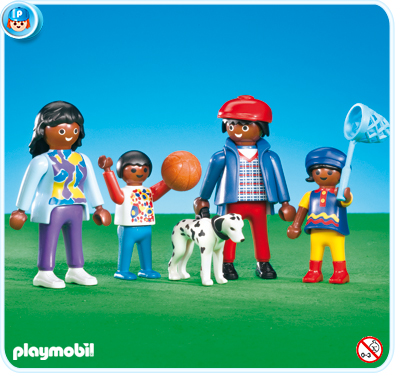
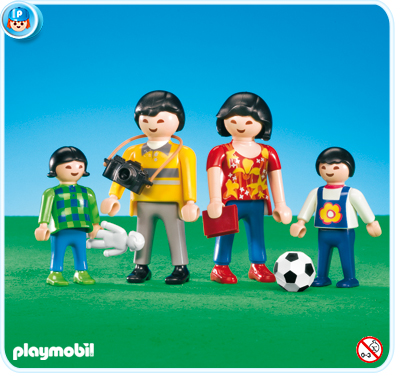
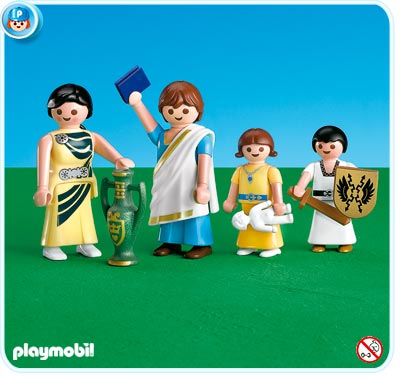
Comments 42
Elena — August 31, 2008
And Romans are way paler than "Mediterraneans". Interesting...
Kirsten — August 31, 2008
Oh, I've only just noticed... Asian Daddy has a camera round his neck, and Asian Mum has (I suppose) a guidebook. Which is rather playing into the European stereotype of the Japanese tourist.
I've often thought the Mediterranean/Hispanic distinction was interesting. As a European, it would never have occurred to me (until I was told) that people of Hispanic descent are not considered "white" in America. But on the other hand, to my eye the Playmobil "Romans" look terribly pallid for Italians. (Perhaps they're Roman citizens of non-Italian heritage, of course. But I doubt the toy designer had that in mind.)
Monkey Plunger » Blog Archive » The Social Construction Of Race By Playmobile — August 31, 2008
[...] THE SOCIAL CONSTRUCTION OF RACE BY PLAYMOBIL: [...]
Eric Stoller — August 31, 2008
Looks like Playmobil thinks that Native Americans walk around in regalia all the time...so untrue. And why is everyone but the Native folks on green grass? Native Americans only exist in regalia and in the desert wtf??!! Also, the Native American boy doe not have shoes on...why? WHY! These toys are so messed up.
Penny — August 31, 2008
All true, but remember that there's nothing stopping you from mixing and matching at home... give the Roman girl's doll to the African-American boy, match up a couple of the moms, attach the baby carrier from the Native American set to the back of the Asian dad.... My kid would make any and all of these modifications to the catalog norm, and then mix them in with the pirates and aliens and random Polly Pockets... It's always been our practice to break up the "sets" as quickly as possible.
Sex. Money. Blogging — August 31, 2008
I notice Black Dad also appears to be popping his collar.
Eric Stoller — August 31, 2008
@Penny - I agree that there is nothing stopping us from mixing and matching. However, the initial sets and imagery are reinforcing societal stereotypes. Give me toys that do not reify the dominant paradigm.
Nadav Perez — August 31, 2008
nitpicking - romans in nikes are as common as native americans in nikes.
which brings the question why do we have such a clear distinctions between the use of the term 'romans' as wcitizens of the ancient roman empirew, and its use as winhabitants of the modern city of rome', but we don't have a matching distinction for native americans.
Penny — September 1, 2008
"However, the initial sets and imagery are reinforcing societal stereotypes." Only if kids *see* the original imagery or see the toys in sets--and they don't have to. My kid never did, because the bin was handed down from friends' kids. The toys themselves have way more potential (the clothes/hair/accessories are all interchangeable, for example; and all the people have flat feet, unlike Barbies, allowing more positioning options).
Happens I just cleaned up the room where most of the playmobil stuff lands... there weren't many obvious "family" groupings, but the purple magician's costume was on a pale blond person with curves, who was near a darker-skinned person with light grey hair wearing some kind of forest costume with a Star Trek phaser in hand... and the biker dude (long red hair and beard, plaid shirt) was with them, using a crutch. There was also a random non-playmobil vampire and alligator in the mix--and some kinda ballerina, too. And lots of legos. Now they're back in the bin jumbled with heaven knows what, awaiting the next exciting installment. Not a dominant paradigm in sight.
Dave — September 2, 2008
Also, one of the black kids has a basketball.
Christoph — September 19, 2008
Though I never liked playmobil i feel like having to defend them.
The Native American family, as you could have guessed, belongs to a Wild-west-Scenario (There's also a wild west family counterpart http://www.playmobil.de/on/demandware.store/Sites-DE-Site/de_DE/Product-Show?pid=3365-A&cgid= )
Did you ever ever see toys of Native Americans with nikes on?
Sociological Images » WHAT DOES “BLACK” AND “WHITE” LOOK LIKE ANYWAY? — October 24, 2008
[...] great opportunity to think a little bit about the social construction of race (see also here, here, here, and here). Comments from both me and Gwen after the [...]
anotherLisa — February 28, 2009
I am black and I grew up in Germany. Therefore I had many opportunities to see how some people here think about race. I think it's not unlikely that, by including these racially marked families, playmobil thinks that they are being open minded and politically correct. So to show how open minded they are they do not only include "white" families, but also families of different races. They just fail to see how stupid their stereotypes are.
Max — September 15, 2009
i think you're reading WAY too much into these toys-- playmobil certainly had a history of CULTURAL stereotypes (i remember the african tribesman with the towel on his head) but they've been trying to modernize and diversify their collection to remove those preconceived stereotypes. AS YOU CAN SEE IN YOUR PHOTOS, the white family and black family and asian family and hispanic family all are basically the same except for their skin colours... the black kid has a basketball? the asian dad has a camera? those toys are put into the boxes at random-- now YOU sound like the racist pointing those things out.
also, as was stated above, the native americans and romans are part of "historical" sets from the old west and ancient Rome. they are not meant to represent modern cultures.
the fact that these toys are made in Germany probably makes them even more sensitive to cultural diversity-- your tone hints at some anti-German racism which is uncalled for in today's day. indeed, racism is far more prevalent in the United States than in Germany in the current day.
Baxter — May 28, 2010
holy hell, matt k, she was talking about the kids' toys, not the dad's camera. how's about you actually read things before you bash them.
Rodo — December 15, 2010
All this politically correct poppycock is for those with no imaginations. Behold the many websites dedicated to customizing stock Playmobil figures or even the unexpected combinations made by children at play.
Furthermore, I hate it when people don't do their research-
you missed the Royal family (3835) - not so racially homogenous after all.
Alex — March 13, 2011
I'm just as scared of over-sensitive PC'ers as I am of racists - both have a tendency of jumping on *whatever* to prove their respective points. Who said the Native American toys are supposed to be of *modern* Native American families? As someone else pointed out, it's part of a Wild West scenario. I think historical or culturally traditional toys are more interesting, educational, and valuable than wholly homogenized ones. I don't approve of Nikes and I don't want a set of toys where EVERYONE is the same, in grey tees, jeans, and Nikes with just skin color to distinguish them. I'd prefer one where everyone is in buckskin, shoeless, and sporting bongo drums but that's just as "random" and meaningless as everyone in Nikes. And I, for one, wholly support basketball AND photography. The gender-specific toys are a little *hmph* but better than than everyone getting their own awesome grey ball and calling it a day. Boring.
Ann — March 24, 2011
I thought the 'boys' in most of the families (except Med/Hispanic) were girls with short hair! The clothes weren't stereotypically 'gender specific' enough for me.
But the 'Native American' one, the kid in the middle was 'boy' to me initially, which probably means I equated 'longer hair' as a historical Native American thing and the blue shirt as 'boy'.
It's interesting to see that these stereotypical markers (race/gender) needs to be used by the company to respond and reinforce systemic racism and sexism ideas. What are they to do? (re e.g. the case of making gender specific markers for 'boy' for me) It's a never ending circle. Do we blame them, what are they to do?
Soziale Konstruktion von Verbreche(r)n | Criminologia — April 9, 2011
[...] Hautfarbe zu existieren scheinen; ganz anders z.B. in der US-amerikanischen Playmobilwelt (siehe: The Social Construction of Race by Playmobil). AKPC_IDS += "5511,"; Verwandte ArtikelSecurity-Check im [...]
beru — April 28, 2011
Has anyone else noticed that the Africans/African-Americans are the only ones to show the whites of their eyes? And only the parents!
Guest — June 20, 2011
Most hispanics look nothing like the toys that represent them. For instance, in the Equitorial Guinea in Central Africa the speak and echo Spanish and the culture. They are considered Hispanics but most of them are black or mulatto. They look nothing like the Playmobil here. Latinos are Hispanic too, but many have white or olive colored skin. They might have wanted to say Metizo or just Meditterean.
The Aisian family have slit eyes. Isrealites and Indians are Aisian but they look nothing like that. The correct term would be Oriental.
Did any one notice the Aisian mom has a book? The black boy has a basketball? The Hispanic kid has a skateboard? The Roman dad has a book? How racist!
Guest — September 2, 2011
It's unfortunate because many well meaning parents will buy these, trying to give children a perspective of diversity, when in fact they aren't representative of that and only are rigid stereotypes.
Kelli Rose — September 20, 2011
I think we all need to get a grip from a Preschool Curriculum coordinator. I have to buy this stuff. I buy toys and dolls that represent the children I serve. I am getting a little tired of the Asian nonspecific except for the shape of the eyes dolls. Alot like the Barbies that are all exactly the same expept for the skin color and hair. Culture is about so much more that skin pigment and hair color. I try to incorporate all of the things that make up a culture in our dramatic play centers and room decorations.
AukeVanderHoek — October 31, 2011
I just counted all the play figure in the 2011/2012 catalogue: ±968 figures. Including 44 figures that are robots, skeletons, spooks, clearly non-white and two 'Zwarte Pieten/Black Peters', the helpers of the white Sint Nicolas. I prefer my son to play with Lego.
Laura — December 24, 2011
I would just like to state that many of playmobil's sets are historical based. Like the Roman sets are based on ancient Rome(which this family actually was a part of). The Native American family above was ment to go with another historical them set of theirs based on the Wild West times. As for the gender oriented toys, boys and girls just tend to gravitate towards certain toys despite your best efforts and I think Playmobil realizes it. I have tried throughout my son's 3 years of life to get him interested in all types of toys. He only plays with the vehicles and dinosaurs. He also enjoys sports and sports balls despite the aversion his father and I have to sports and sports fans. Though he does like his toy kitchen and the color pink.
gruff — July 4, 2012
What's wrong with having a dominant paradigm?
A Simple Lesson on the Social Construction of Race | Moorbey'z Blog — June 12, 2014
[…] More on the social construction of race: black and white twins and Playmobil families. […]
rdinsd — August 3, 2014
I would just be happy to find an african american family for my mixed race grandchildren that doesn't cost $60. Now that is racist!
Andrea Hernandez — January 16, 2015
It's crazy to see how gender and racial stereotypical Playmobil toys have become. I recently walked into a Toys R Us and the first thing that I noticed was the color labeling of the products. Pink for girls and blue for boys. I know women and men are different biologically, but who gets do decide what is designated for boy and girls. We should let toys be toys and give children the option to chose what they want to play with. What really scared me is that one of the toys Playmobil has is housekeeper set, which specially pin points a Mexican American women. You can tell by the skin and hair color. This is showing our children that it is the woman's responsibility to clean and keep the household on check. It also pushes the racial stereotype that Mexicans are the people who clean because they can't receive a better education or might be illegal immigrants and can't have a career. Playmobil toys have become so stereotypical and the fact that these toys are geared for children of the ages 2-10 just shows us how early on in a child's life we are pushing prejudice beliefs. A way to fix this issue is by making multiple racial characters that will fit in any PLaymobil setting. Also, making the product labels more contemporary and neutral. We need to set a right example for our children and show them at a very early age that it's not ok to judge a person based off their color, social status, or any other characteristic. We need to remember that we are all equals.
altair — October 23, 2018
The "native american" generic person with headress etc(which apart from them not dressing u in full regalia in everyday life is also horrible stereotyping by putting all 100 or so different people into one pot and deciding THIS is how they looks like. It is unfortunately a big problem in Germany in is pervasive because no one ever seems to think about it in the kids toys industry. Another imperialist patriarchal theme that worried me is that you basically find all western coloniser armies in their orginal regalia of the last 500 years as figures, Confederates , red shirts, prussians, french, etc. I think thats definitely catered to parents rather than kids. and very worriying there were fully "armed" swat teams and similar police squads in sets. and a "police and thief" set that made the thief not look like an ordinary person but it was rather classist.
Agamemnon — June 17, 2019
The Romans are paler than the modern Mediterranean family because I think that family are actually literally Hispanic... which contrary to what someone says above, refers to Latin Americans, who are mostly of mixed-Amerindian and European heritage (some areas being of mostly native heritage such as Peru, Bolivia, Paraguay (despite their government's claims of Italian heritage!!!) and parts of Mexico and other Central American nations. They'd be decent representations of modern Native Americans, as the ones pictured are from a historical range.
If they were supposed to be modern Italians it isn't so bad, as Ancient Romans of wealth (such as that family) avoided tanning and even used skin whitening products, unlike modern Italians.
Also, I am not sure why people brought Lego into this. Lego have clear divisions between female Lego (like Friends and an earlier beach-themed range) with purples and pinks, and had a poor track record with ethnic diversity when examined closely - I loved the range, but the enchanted islanders from the pirate range were hardly accurate representations of Polynesians... who were seemingly mixed up with Native American Arawaks in one or two sets because presumably the designers of those specific sets didn't know who they were meant to be.
I like Lego and Playmobil and both aren't that bad now when it comes to diversity. I think you are being needlessly ''PC'' and fitting into the stereotype of SJWs created by repugnant right-wingers.
Ellen Masterson — January 14, 2020
Twelve years after you all beat the stuffing out of Playmobil, I’m trying to buy little figures of people to occupy kids at low income school based clinics in my city. Ideally these dolls would sanitize easily (why Playmobil is best) and would mostly be black, brown and Asian figures, so they look like the kids at the clinic. They cannot be found in the US.
This intellectual dissection of these products neglected to take into account two things.
1) When you throw away the packaging and toss the dolls in the tub with the other little dolls, you have multicultural toys. The kid probably didn’t read the label and wasn’t effected by the stereotyping. Most parents realize this.
2) Corporations don’t like bad press, so rather than redesigning packaging, product naming and repackaging multicultural families, they just scrap the products. It’s more affordable and takes away the opportunity, for most likely childless younger adults, to bash them.
Try to find durable little dolls with various skin tones. It’s really difficult. And comforting a kid at a clinic is more important than your harmful critique, even if you didn’t intend to create less diversity in toys.
bran — August 4, 2020
Ellen, there are plenty of non-white Playmobil characters. My son has many of them. They come with the playground, in the space collection, in the Ghostbusters collection, the hospital carry along set (the doctor is black), soccer sets, etc. We've never bought single Playmobil figures new because we get plenty with the sets, which is how most casual consumers acquire them. You can buy individual figures you want on eBay. I don't understand how you think they're not available in the US.
The thing I have a problem with is the crazy eyes of the dark-skinned figures. Can they not use maybe one shade lighter on the dark skinned figures so that they can use a higher contrast black for the eyes and do away with the crazy whites-of-eyes look? The pupils aren't even looking the same direction, did you notice that? To me, that's the most egregious thing about Playmobil and race. I don't have a problem with OBVIOUSLY historical figures. I don't care to split hairs over what constitutes Mediterranean etc, because little kids don't care about that either. But I feel bad for the black or Indian boys and girls who are handed one of the wild-eyed ones and told "here Suzy/Johnny this one looks like you!" Make them as cute as the others!
Philip winter — March 26, 2021
I am trying to build a Playmobil airport scenario for my grandson, who like myself, is of white British descent. I’m dearly wanting to find some passengers (and staff) from mixed ethnic and religious origins. This is supposed to represent a global airport, so surely we need global figures. Is this just an oversight by Playmobil, racial insensitivity, or out and out prejudice?
C M L — January 28, 2022
Speaking as a Playmobil collector who is also black, I find this post to be an incredible reach. All the company is doing is trying to keep things generic. While I don't about those "stereotypes" you pointed out with the other families, but the basketball in the black family doesn't come across as offensive at all to me. That's because some stereotypes have truth in them. And the truth is a lot of black people play basketball. In every neighborhood, save one I think, I've lived in, there was always a group of black boys playing basketball outside.
Now does that mean every black boy under the sun plays it? Of course not! But enough of them do to where it's a recognizable trait to a degree. And I believe that's the ultimate end goal. But of course if buyers don't like it, there's always the option to just ignore it or change it. Getting all up in a fit over mere marketing strategies, is only going to encourage your children to see problems that aren't there. It's also discouraging them from finding very basic solutions to these "problems".
Finally, the beauty of such generic looks like these is that they can be any race you want. The tan people could be Latin American, Middle Eatern, Indian or Native American. The darker skinned people could be American, African, Australian, even South American. There's nothing stopping a child from seeing these figures differently other than adults trying to be politically correct.
C M L — January 28, 2022
Also, for those who are wondering why the darkest skinned klickies have eye whites, that's because the face of a klicky is actually injected through the inside of the head. It's always been brown throughout their history, probably because it looks more welcoming than say, black. So without the eye whites, the face would blend in. And before you ask, "Why can't they just use different colors for darker skinned klickies?" Most likely because it would cost more than simply painting whites on the eyes. It's also probably quicker to just have the same color be used regardless of skin tone like they've always done. You can see it for non humans like the rabbit people and aliens.
Personally, I like it this way! It makes them look more expressive. Of course the painting can be skewed a bit, but I think it only adds to the charm. :)
Anonymous — August 29, 2022
Grown adults crying over innocent childrens toys.
This is really quite pathetic/mentally backwards.
Adults, are often more childish than children.
Stereotypical toys are based on generic truths.
Not on bigotry. 99% of things are conventional.
Its the 1% who become mentally warped by trying to be special heroes, that nobody wanted or asked for.